Oerlikon GDF
The Oerlikon GDF[3] or Oerlikon 35 mm twin cannon is a towed anti-aircraft gun made by Oerlikon Contraves (renamed as Rheinmetall Air Defence AG following the merger with Rheinmetall in 2009). The system was originally designated as 2 ZLA/353 ML but this was later changed to GDF-001. It was developed in the late 1950s and is used by around 30 countries.[4]
| Oerlikon GDF | |
|---|---|
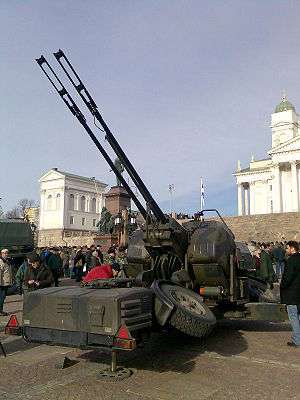 A modernized Finnish 35 mm Oerlikon twin cannon | |
| Type | Autocannon |
| Place of origin | Switzerland |
| Service history | |
| Used by | See operators |
| Wars | Falklands War |
| Production history | |
| Designer | Oerlikon |
| Manufacturer | Oerlikon |
| Specifications | |
| Mass | 6,700 kg (14,800 lb) (with ammunition) |
| Length | 7.8 m (25 ft 7 in) (travelling) |
| Barrel length | 3.15 m (10 ft 4 in) (barrel) |
| Width | 2.26 m (7 ft 5 in) (travelling) |
| Height | 2.6 m (8 ft 6 in) (travelling) |
| Crew | 3[1] |
| Shell | Complete round: 35×228mm, 1.565 kg (3 lb 7 oz) |
| Caliber | 35 mm (1.4 in) |
| Action | Gas-operated[2] |
| Carriage | 4 wheels with outriggers |
| Elevation | −5°/+92° |
| Traverse | Full 360° |
| Rate of fire | 550 rounds/min (per barrel) |
| Muzzle velocity | 1,175 m/s (3,850 ft/s) (HEI-T) |
| Effective firing range | Ceiling: 4,000 m (13,000 ft) |
Design and development
The system uses twin autocannons, firing 35×228mm NATO-standard ammunition. It was originally designated 353 MK and is now designated as the KD series. The same KD series 35mm cannons are used in the Leopard 1 based Gepard and Type 74 tank based Type 87 SPAAG and Marksman self-propelled anti-aircraft guns (SPAAG). The system could be paired with the off-gun (remote) Super Fledermaus fire control radar, which in the late 1970s was upgraded to the Skyguard system. The weapons was aimed either directly, by way of an advanced sighting system, or automatically, by locking onto the target with radar. Early models carried 112 rounds ready to fire, and an additional 126 stored on the chassis as reloads. Later versions with automated reloading carry 280 rounds total. A typical engagement burst is 28 rounds.[3]
In 1980 an upgraded model, the GDF-002 was produced, which featured an improved sight, and the ability to be directed by an off-gun digital control system. A few years later a third version of the system was being produced, the GDF-003, which was broadly similar to the GDF-002, but included some enhancements like self-lubricating weapons and integrated protective covers.
In 1985 a further upgraded model was produced, the GDF-005, which was introduced, featuring the Gunking 3D computer-controlled sight with an integrated laser range-finder and digital control system. The GDF-005 also introduced an automated ammunition-handling system, which eliminated the need for the two reloaders, reducing the crew from 3 to 1.[3]
The guns are usually transported by a 5-tonne 6×6 truck.
KD series cannons
Development of the KD series cannon began around 1952 soon after Oerlikon calculated that 35 mm was the optimum calibre for an anti-aircraft gun. The KD series cannons were a design adapted from the post-war 20 mm KAA 204 Gk cannon. Several designs were developed, including a water-cooled design, designated Mk 352, which was tested by the U.S. Navy. The final design was the Mk 323, which was developed in two variants, a belt-fed version the KDA, and a linkless version the KDC, fed by seven-round clips. Both designs are gas-operated, with a propped-lock locking system.[5]
Super Fledermaus
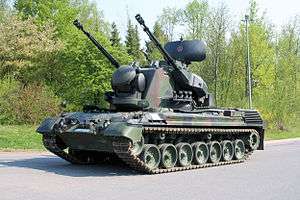
The Super Fledermaus fire control system was designed and built by the then separate Contraves company. It consists of a four-wheeled towed trailer with an E/F band pulse doppler search radar with a range of around 15 km and a pulse doppler tracking radar operating in the J band, also with a range of 15 km. It was also used as the fire control system on the Gepard SPAAG.
Skyguard
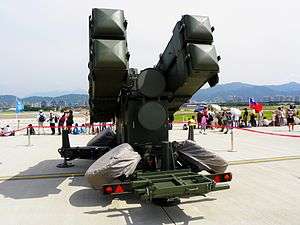
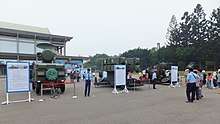
The Skyguard system is contained within a towed trailer, mounted on the roof of which is a pulse doppler search radar, a pulse doppler tracking radar and a co-axial television camera. The trailer also houses the crew of two and a small petrol generator. Skyguard is an all-weather air defense system for the control of aircraft at low altitude and at low and medium altitude range up to 3,000 m. The maximum effective distance is given as 4,000 m. The system takes the air surveillance, target acquisition, calculation of the derivative-action values and the control of two Oerlikon 35 mm anti-aircraft guns. Skyguard is served by four people.
It was created by Oerlikon-Buehrle. The weapon was introduced in the 1960s in the Swiss Army and got updates in 1975, 1995 and 2010. They are still in use. It had replaced the system Contraves Super Fledermaus in the Swiss Air Force. The Skyguard radar system was used in the German Air Force for surveillance of low-altitude flight zones. The radar unit is readied quickly through the use of hydraulic systems for antenna erection and leveling after deployment. A typical fire unit using the Skyguard consists of two twin 35 mm gun platforms with a single Skyguard fire control radar.
Skyguard systems can also incorporate an optional SAM module based on the GDF's mount and radar system but with the guns replaced by four missile canisters. It can be armed with either Aspide or RIM-7 Sea Sparrow missiles. In Greek service the Skyguard system with RIM-7M is known as the VELOS.[6]
History
- 1982: The system was widely used by Argentine forces during the Falklands War. The Skyguard radar system was employed by the 601 Antiaircraft Artillery Group and the Super Fledermaus by the 1st Group of the Argentinian Air Force. The Skyguard succeeded in shooting down a Sea Harrier (XZ450) on 4 May 1982 at Goose Green. This resulted in a shift of tactics, so that British aircraft largely operated outside the weapons system's range. An RAF Harrier (XZ988) was shot down by these cannons again over Goose Green on 27 May.[7] The system was also employed in direct fire mode against British paratroopers during the Battle of Goose Green, killing two and wounding 11 and stopping the advance of two companies.[8][9] The guns were involved in two deadly friendly fire incidents during the campaign. The first took place on 1 May 1982, when a GADA 601 battery fired three burst of 35 mm rounds at an Argentine Mirage III attempting to make an emergency landing at Stanley,[10] after the aircraft had been already targeted by Argentine Marine Hispano-Suiza HS-831 30mm guns deployed along the town. The aircraft fell in flames north of the airport, killing the pilot.[11] The other friendly shootdown occurred at Goose-Green, when one A4 Skyhawk flew by mistake over a banned zone, and was shot down with the loss of the pilot. The Argentine Air Force conceded that this time the incident was triggered by the pilot's navigation error.[12] The Skyguard radars were targeted by the RAF during Operation Black Buck on May 31 and June 3. One Skyguard radar was destroyed by shrapnel from a Shrike missile strike and four operators died as a result. Another Harrier (XW919) was presumably hit by 35 mm splinters over Sapper Hill on June 12 and sustained heavy damage.[13][14] The aircraft was later declared out of service. There was a further direct-fire mission conducted against British troops on Wireless Ridge, just hours before the Argentinian surrender.[15] After being disabled by their operators the guns were captured by British forces. Fifteen guns and five Skyguard units were captured and shipped back to Britain in Operation "Skyguard". Four of the Skyguard sets were in good enough condition to be refurbished by BMARC in Britain with the fifth being damaged by its operators prior to capture so severely that refurbishment was not economically viable. Twelve guns and four Skyguard radars were put into British service operated by a reserve wing of the RAF Regiment 1339 wing Royal Auxiliary Air Force, comprising 2729 Squadron and 2890 Squadron Royal Auxiliary Air Force Regiment, based at RAF Waddington with an additional two new Skyguard units being procured from the Manufacturer. The RAuxAF Regiment used these guns and radar for about 10 years but defence cuts, coupled with the rising cost of ammunition and replacement gun barrels, forced the withdrawal from service of the very popular and reliable system.[16][17] One of the guns is on display at the RAF Regiment Heritage Centre at RAF Honington, and the Skyguard radar system is still in use by the RAF to monitor military low flying in the UK.
- 12 October 2007: Nine South African National Defence Force (SANDF) soldiers were killed and 14 injured by the system during a training exercise at the SANDF Battle School at Lohatla in the Northern Cape province. A line of eight cannons were engaging a tank hulk in manual ground fire with the guns at low elevation and the maximum traverse of the barrels secured by safety poles and tethers. The rightmost gun jammed while firing and had to be repaired by technicians. Shortly after the gun was cleared to fire again, the gun malfunctioned, entered automatic mode, broke through the traversal-restriction safety mechanisms and began firing, striking the other guns along the firing line. Initial reports suggested that the malfunction was caused when the gun underwent an unexplained hang fire of the explosive 35mm ammunition in the magazines, causing the turret to swing uncontrolled through 360 degrees, firing wildly until it exhausted its remaining ammunition. A statement issued by the South African Defense Minister, Mosiuoa Lekota, however, stated that the gun had inexplicably traversed 90 degrees to the left, breaking through the safety mechanisms, and fired only a 1⁄8-second-long burst, striking all of the soldiers located on the right-hand side of their guns.[18][19] The accident report published by the SANDF in January 2008 blamed "undetected mechanical failure—which the manufacturers of an anti-aircraft gun allegedly kept secret". The report says the gun malfunctioned because a spring pin, which is the size of a matchstick, sheared. Other sources blamed poor training and safety procedures in the SANDF.[20]
Ammunition
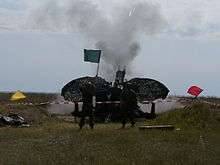
| NATO designation | HE-T/HEI-T | HE/HEI | HEI(BF) | SAPHEI/SAPHEI-T | APDS/FAPDS | TP-T/TP | AHEAD |
|---|---|---|---|---|---|---|---|
| Projectile weight | 535 g (18.9 oz) | 550 g (19 oz) | 550 g (19 oz) | 550 g (19 oz) | 375 g (13.2 oz) | 550 g (19 oz) | 750 g (26 oz) |
| Explosive | 98 g (3.5 oz) | 112 g (4.0 oz) | 70 g (2.5 oz) | 22 g (0.78 oz) | n/a | n/a | n/a |
| Propellant | 330 g (12 oz) | ||||||
| Complete round | 1,565 g (55.2 oz) | 1,580 g (56 oz) | 1,580 g (56 oz) | 1,552 g (54.7 oz) | 1,440 g (51 oz) | 1,580 g (56 oz) | 1,780 g (63 oz) |
| Muzzle velocity | 1,175 m/s (3,850 ft/s) | 1,175 m/s (3,850 ft/s) | 1,175 m/s (3,850 ft/s) | 1,175 m/s (3,850 ft/s) | 1,440 m/s (4,700 ft/s) | 1,175 m/s (3,850 ft/s) | 1,050 m/s (3,400 ft/s) |
- Designation:
- HEI: High Explosive Incendiary (-T—Tracer)
- SAPHEI: Semi-Armour Piercing High Explosive Incendiary
- FAPDS: Frangible Armour Piercing Discarding Sabot
- AHEAD: Anti-missile rounds, that fire "152 heavy tungsten metal sub-projectiles".
- TP: Target Practice (-T—Tracer)
Versions
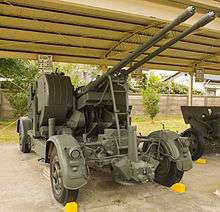
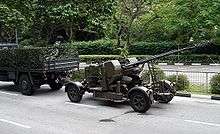
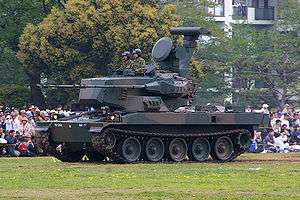


- GDF-001 / 2 ZLA/353 MK: XABA sight
- GDF-002: Introduced in 1980. Improved Ferranti sight and digital data bus. The gun has 112 rounds ready and 126 in reserve (238 rounds total)
- GDF-003: Minor enhancements including protective covers and automatic weapon lubrication.
- GDF-005: Introduced in 1985. Fitted with Gunking 3D computer-controlled sight with a laser range finder and digital fire control system. Integrated power supply and diagnostics. 280 rounds on the gun and an automatic re-loading system.
- GDF-006: GDF-001/002/003 upgraded with AHEAD system.
- GDF-007: GDF-005 upgraded with AHEAD system.
- GDF-009: Unveiled at IDEF 2015, held in May 2015 in Istanbul. To date, its exterior significantly changed, although the installation has retained the design of the original serial versions of the systems.Unlike other variants, this one relies on an internal power source.The GDF-009 model is based on a four-wheeled carriage, and is raised off the ground by three stabilisers when deployed in the firing position. It also features an automatic levelling system that can compensate for a maximum tilt angle of up to 7°.Mounted on the forward part of the carriage is the integrated battery, which functions as the gun's power supply unit and can be recharged from an external source if required.[21]
- AHEAD: An upgrade for the GDF series guns built around a special projectile which explodes at a pre-calculated point in front of the target, sending a cone of 152 tungsten sub-projectiles at the target. Used by Canada, Pakistan, Greece, Oman, Spain, Taiwan, and Chile (unconfirmed).
- Gepard: Self-propelled (SPAAG) version of the system based around the Leopard 1.
- Marksman: Self-propelled version of the system based around the Marksman turret, which could be fitted on numerous tank chassis. The only model that went into production was a version based on the T-55 chassis for Finland, seven systems in war reserve. Marksman turrets to be transferred to Leopard tank chassis.
- Type 87: Japanese SPAAG using the system.
- PZA Loara: Polish SPAAG based on the PT-91 tank.
- Type 90 (PG99): Chinese licensed copy of GDF-002.[22] The PG99 is a towed anti-aircraft gun suitable for point and coastal air defence. It is usually deployed near military bases, airfields, tunnels, islands, and along the coast to defend Sea Land of Communication (SLOC), ports, bridges and other important assets.[23]
- CS/SA1: Chinese upgrade of GDF-002.[24] Mounted on the 6×6 SX2190 truck, the PG99 (CS/SA1) is a self-propelled variant of the Type 90 35 mm AA system, previously available only as a towed AA piece.[25]
- Type 09 SPAAA: Self-propelled version of the system based around the Type 90. First appeared in 2015 China Victory Day Parade.
- Samavat: Iranian version of these guns with night vision sight and Used with Skyguard & Super Fledermaus FC radars.
- Amoun: Egyptian version of Skyguard & Sparrow SAM.
Operators
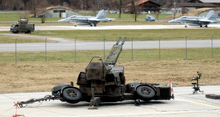






.svg.png)





























See also
- List of artillery
- List of anti-aircraft artillery
- List of artillery of Germany
- List of artillery of Switzerland
- Related development
- Oerlikon Millennium 35 mm Naval Revolver Gun System
- Type 09 SPAAA
References
- Notes
- Foss, Christopher (1977). Jane's pocket book of towed artillery. New York: Collier. p. 227. ISBN 0020806000. OCLC 911907988.
- Friedman, Norman (1997–1998). "Oerlikon 35mm (Type GDM-A and GDM-C)". The Naval Institute Guide to World Naval Weapons Systems, 1997–1998. Annapolis, Md.: Naval Institute Press. p. 455. ISBN 978-1-55750-268-1. Retrieved April 6, 2012.
- "GDF - Weaponsystems.net". weaponsystems.net. Archived from the original on 2016-03-08. Retrieved 2017-07-03.
- "GDF | Weaponsystems.net".
- George M. Chinn, The Machine Gun, Volume V
- "VELOS". haf.gr. Hellenic Air Force. Archived from the original on 18 May 2019. Retrieved 18 May 2019.
- Pook, page 109
- "Goose Green: The Argentinian Story" Archived 2013-10-29 at the Wayback Machine by David Aldea. British Small Wars website
- Reynolds, David (2002). Task force: the illustrated history of the Falklands War. Sutton, p. 150. ISBN 0-7509-2845-X
- Rodríguez Mottino, p. 170
- El derribo del primer avión argentino en Malvinas Archived 2011-07-23 at the Wayback Machine (in Spanish)
- Fernández Reguera, José (1987). La Guerra de las Malvinas. Ed. Fernández Reguera, p. 572 (in Spanish)
- "During the attack, MacLeod's aircraft was hit by shrapnel which penetrated the rear equipment bay area of the aircraft and fractured the aft reaction control air pipe. On decelerating to the hover during the recovery, this caused a fire to start in the rear equipment bay and smoke was seen coming from the aircraft. Fuel indications suggested a considerable fuel leak at the same time. MacLeod executed a very quick and professional landing in worrying circumstances. Having landed-on, the fire was extinguished by the ground crew." RAF diaries, 12 June entry Archived 2015-02-07 at the Wayback Machine
- (in Spanish) En uno de esos ataques -12 de Junio- el enemigo en vuelo rasante (150 mts. del suelo) descargó todos sus cohetes sobre el cañón: resultaron seis heridos leves y fue "tocado" por la propia artillería antiaérea; uno de los sirvientes descargó sobre la máquina enemiga su fusil FAL; el cañón continuó en servicio. Rodríguez Mottino, page 91
- Pook, page 162
- "Falklands Campaign (Captured Weapons) (Hansard, 31 January 1985)". hansard.millbanksystems.com. Archived from the original on 1 February 2009. Retrieved 8 July 2008.
- "Britains Small Wars - Argentine Weapons". Archived from the original on 2009-02-01.
- "Robot Cannon Kills 9, Wounds 14 - WIRED". blog.wired.com. Archived from the original on 2009-04-03. Retrieved 2007-10-19.
- "Google".
- "Pretoria News, p.3 on 2008 January 26". Archived from the original on 2009-02-10. Retrieved 2008-01-29.
- "New anti-aircraft gun Oerlikon GDF-009 from Rheinmetall". WeaponNews. Unknown. 2017-07-25. Retrieved 2019-09-04.
- "Type 90 Twin-35mm Towed Anti-Aircraft Artillery". sinodefence.com. Archived from the original on 2013-04-04. Retrieved 2013-04-24.
- "Wide range of defence solutions available from ChinaPoly Technologies Inc". Jane's Information Group. 20 September 2012. Archived from the original on 12 October 2012. Retrieved 20 April 2013.
- "Pakistan Acquires Chinese Made Air Defence Artillery". Kanwa Daily News. 2013-03-28. Archived from the original on 2013-10-29. Retrieved 2013-04-20.
- Andrew, Martin. "PLA Mechanised Infantry Division Air Defence Systems / PLA Point Defence Systems". Archived from the original on 16 May 2012. Retrieved 20 April 2013.
- "TECHNICAL SPECIFICATION AND OTHER REQUIREMENTS FOR ITEM SER NO 1. CARTS HIGH EXPLOSIVE INCENDIARY (HEI) FOR RADAR CONTROL AIR DEFENCE GUN SYSTEM 35 MM OERLIKON GDF 009/SKYGURAD 3,QTY-1,000 NOS" (PDF). DGDP. Retrieved 3 September 2019.
- "NEWLY ADDITION IN BANGLADESH ARMY ORELIKON RADAR CONTROLLED GUN TEST FIRING HELD AT COXBAZAR". ISPR (in Bengali). Bangladesh. 13 October 2019. Retrieved 14 October 2019.
- Anti-Aircraft Gun, Oerlikon GDF 009 (October 14, 2019). "Oerlikon Radar Controlled Gun". The Financial Express. Archived from the original on 2017.
- de Cherisey, Erwan (13 July 2016). "New Cameroonian air-defence capabilities revealed". IHS Jane's 360. Paris. Archived from the original on 2017-06-14. Retrieved 13 July 2016.
- Type 90 Twin-35mm Towed Anti-Aircraft Artillery. Archived 2013-04-04 at the Wayback Machine Retrieved on August 1, 2008.
- "SIPRI arms transfer database". Stockholm International Peace Research Institute. 18 June 2011. Archived from the original on 14 April 2010. Retrieved 18 June 2011.
- (in Japanese) 35mm2連装高射機関砲 L-90. Archived 2008-12-05 at the Wayback Machine Retrieved on August 1, 2008.
- (in Spanish) Spanish Minister of Defense official website. Archived 2016-06-24 at the Wayback Machine May 2008.
- "MKEK - Makina ve Kimya Endüstrisi Kurumu". www.mkek.gov.tr. Archived from the original on 2014-12-17. Retrieved 2014-05-23.
- Pike, John. "Turkey - Major Army Equipment". www.globalsecurity.org. Archived from the original on 2013-12-02. Retrieved 2014-05-23.
- https://www.forecastinternational.com/archive/disp_old_pdf.cfm?ARC_ID=1651
- "Skyguard", House of Commons Debates, Hansard, 31902, 11 Feb 2002, archived from the original on 19 March 2018.
- Bibliography
- Jane's Land-Based Air Defence 2005–2006, by James C O'Halloran, ISBN 0-7106-2697-5
- RAF Harrier Ground Attack-Falklands, by Jerry Pook, ISBN 978-1-84415-551-4
- The Machine Gun, Volume V, George M. Chinn
- Rheinmetall page on 35 mm ammo
- La Artillería Argentina en Malvinas, by Horacio Rodríguez Mottino. (in Spanish)
- Iran mass-produces 35mm anti-aircraft gun, Press TV. January 15, 2008.
- Weapons: Robot Cannon Goes Berserk, Kills 9
External links
| Wikimedia Commons has media related to Oerlikon 35mm. |